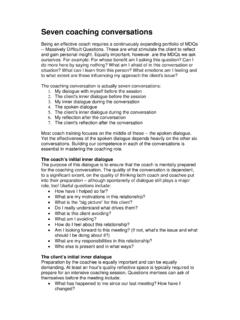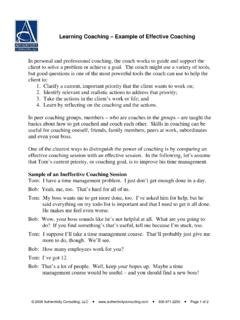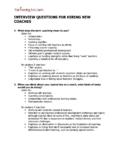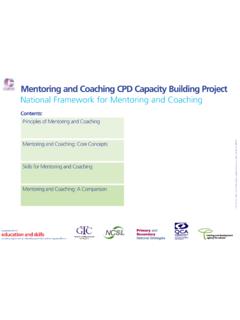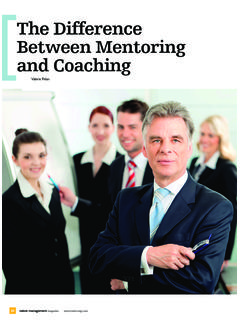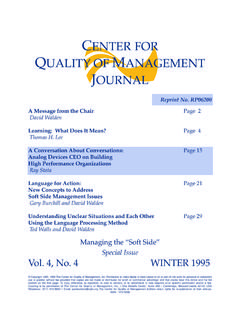Transcription of Coach maturity: An emerging concept - David Clutterbuck
1 Coach maturity : an emerging concept Professor David Clutterbuck and Professor David Megginson coaching sometimes seems like Keats rainbow the more we try to define it, dissect it, classify it and demystify it, the more we diminish it and lose its essence. One of the concerns both of us have about so much of the coaching literature is that it represents attempts to confine coaching within the partisan wrappings of a particular school, philosophy or approach. Such narrow and sometimes self-serving perspectives seem to us to be completely at odds with the essential ethos of coaching enquiring, open, inclusive, subtle and multi-perspective. This perspective has been called relational coaching by Erik de Haan and colleagues (de Haan, 2008). At the same time, we accept and encourage the notion of quality in coaching , even though we may struggle even more in defining what that, too, means.
2 Ingredients in a definition of quality of coaching might be posited to include: The delivery of intended and positive unintended outcomes. Simply delivering against the initial, presented goal is not necessarily an indicator of quality, for a number of reasons: The goal may be the wrong one for the client and or the organization. Achieving goal clarity may be the end point, not the beginning of the coaching assignment many clients need coaching to establish what they want and why, but are self-sufficient in thinking through how they are going to achieve it. Even coaching at a relatively low level of competence can achieve change in the client. Simply being there and allowing the client to talk things through can be remarkably effective, where the client needs only to structure their own thinking. The primary skills required in such cases are attentive listening and knowing when to shut up!
3 Depth of rapport, which may in turn relate to attentiveness, awareness of one s own values, and authenticity. Energy: Observation of coaches in assessment centre real plays suggests that the most effective coaches create simultaneously an intense stillness and an intense energy field. The space between them and the client almost crackles! By contrast, the least effective coaches seem to drain the energy from the room. By contrast, the least effective coaches seem to suck energy from the room, dissipating energy as they flail about seeking to plug in to the client and his or her issues. A systemic approach to the coaching dynamic. The coaching context extends beyond the individual client to the human and organizational systems, in which they operate. Observations about coaches and coaching Our observations of many coaches in and out of action in the context of Coach assessment centers suggests that it may be easier to define what does not define quality for example: Having a certificate or diploma.
4 At best this is a hygiene factor, indicating that the Coach has undergone some form of training in the role. But rigorous assessment shows that many certified coaches are severely lacking in competence (), while many of the most effective coaches are naturals , who bring to the role a mixture of innate intuitiveness and reflection on experience. Having individual accreditation. The International Coach Federation, the Association for coaching , the European Mentoring and coaching Council and others (Brennan and Whybrow, 2010) have set up systems for individual accreditation. This seeks more directly than certification to measure something akin to maturity . However it largely shows that the Coach is good enough, rather than how far on a personal journey they have travelled. Client satisfaction. Some clients may over-rate the efficacy of their coaches, confusing empathetic conversation (simply having someone listen to them) with transformational dialogue.
5 Fee rates. We have found a variation of 15 to 1 in fees charged per hour, but no significant correlation with quality of coaching delivered. Our reflections to reconcile the spontaneity, dynamism and variety of coaching with the need to maintain standards lead to the conclusion that simplistic classifications are likely to be divisive and of dubious validity. What s needed is a conceptual framework that reflects the evolution of complexity in coaches way of thinking about themselves, their clients and the context, in which they operate. A possible solution may lie in the context of maturity . In the sense of the development of human beings, a number of authors have proposed models of the evolution of maturity . These models broadly assume that changes in the structure of thinking about oneself and the world, with which we interact, evolve slowly and in recognisable, sequential patterns; that higher levels involve a greater degree of awareness about the individual s environment, and greater complexity in how they interpret their environment; that evolving through one level is an essential precursor to the next; that cognitive and socio-emotional responses at earlier levels may remain open and available, even though the individual s centre of gravity is at a higher level; that people evolve at different rates; and that only a small proportion of the population become centred in the highest levels of maturity .
6 These models tend to emphasize either cognitive-reflective processes or ego-development (Bachkirova and Cox, 2007), meaning the development of self-identity and maturing of interpersonal relationships . Key authors here include Torbert (1991), Wilber (2000), Cook-Greuter (2004), Beck & Cowan (1996) and Kegan (1992). As Bachkirova and Cox express it: What is particularly important in relation to development of coaches is that each stage enriches individual capacity for reflection and effective interaction with others. Their ability to notice nuances and details of situations is increasing. The resultant self-awareness gives them a better opportunity to articulate, influence and potentially change these situations. Otto Laske (2006, 2009), who has built in particular upon Kegan s approaches, maintains additionally that in a coaching context the relative maturity of the Coach and client are significant in the relationship dynamic.
7 Most importantly, if the Coach is less cognitively or socio-emotionally mature than the client, this is likely to have a significant and negative impact on the quality of the coaching process. Chandler and Kram (2005) make a similar point with regard to the related activity of mentoring. Mindsets and models Our own interpretations of Coach maturity are not based on empirical research, but we hope they will stimulate such research and serve as a starting point for debate. Our model derives from observation in a variety of contexts, but particularly within Coach assessment centers, where it is possible to benchmark coaches against consistent criteria, and hence to reflect on characteristics and thinking patterns exhibited by coaches of different levels of demonstrated competence. It is important to emphasise here that we are not equating maturity and competence as the same construct.
8 However, it is reasonable to conclude that they are closely related. The four levels are models-based, process-based, philosophy or discipline-based, and systemic eclectic. Models-based coaches are often very new to the field and seek the re-assurance of a closely defined approach that they can take into any situation they might meet. This type of coaching is characterised by mechanistic conversations, where following the model is more important than exploring the client s world. It is about doing rather than being and tends to be about coaching to the client than coaching with the client; and about the coaching intervention, rather than the coaching relationship. The dangerous myth that a good Coach can Coach anyone in any situation appears to stem from this very narrow perception of coaching . Process-based approaches allow for more flexibility. They can be considered as a structured linking of related techniques and models.
9 The Coach has a number of specific tools to use in helping the client s thinking, but the toolbag is still relatively limited. Solutions focus, for example, assumes that the client s immediate need is to find a solution, but in practice, many clients simply want to build a greater understanding of their situation and/or to come to terms with a problem that is inherently insoluble. Yet there are many coaching situations where the emotional engagement between Coach and client provides the most powerful resource for change. Philosophy or discipline based mindsets tend to offer a wider still portfolio of responses to client needs, because they operate within a broad set of assumptions about helping and human development. They can still be applied mechanistically, however. What prevents them being so is the Coach s ability to reflect on his or her practice, both while coaching and after each coaching session.
10 The fourth, most liberating mindset is the systemic eclectic. These coaches have a very wide array of ways of working and a toolkit amassed from many sources, both within couching and from very different worlds. They have integrated this into a self-aware, personalized way of being with the client. They exhibit an intelligent, sensitive ability to select a broad approach, and within that approach, appropriate tools and techniques, which meet the particular needs of a particular client at a particular time. This relates to what Webb (2008) calls coaching for wisdom. Observation of and discussion with a sample of systemic eclectic coaches suggests that: They have immense calm, because they have confidence in their ability to find the right tool if they need it Yet they hardly ever use tools. When they do, it is subtly and integrated almost seamlessly into the conversation.
